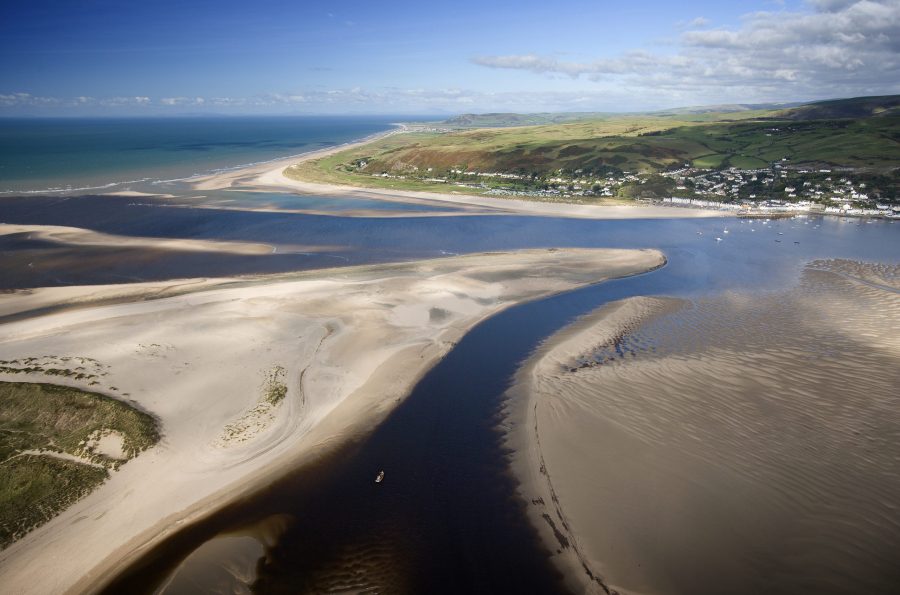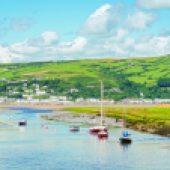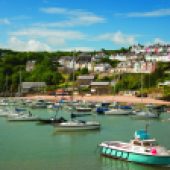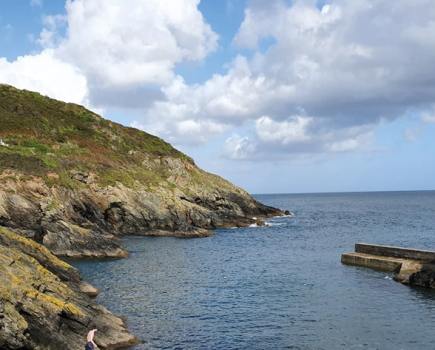Britain’s varied coastline lends itself well to road trips – classics include the spectacular Antrim coast of Northern Ireland, the castles and broad, sandy bays of Northumberland and the ‘olde-world’ charm of the Norfolk coast. These beautiful drives can easily be done in a day, or you can go as slow as you like and explore more over a longer period – it’s a great way to blow away the cobwebs and refresh body and mind. And the journey I’m about to enjoy is right up there with the best.
Wales’ Coastal Way is a 180-mile route around Cardigan Bay, starting at St Davids in Pembrokeshire and finishing in Aberdaron on the Llyn Peninsula. And, since these locations are two of the most beautiful peninsulas in Wales, I’ll also be enjoying two lovely coastal walks at the beginning and end of the drive. Which is how I find myself standing atop 181m-high Carn Llidi above Whitesands Bay, with spectacular views over to the islands and islets that dot the shimmering blue Irish Sea (Ireland itself is sometimes visible on very clear days), while inland the rounded summits of the Preseli Hills beckon.
Having taken in the seascape I descend and walk out to St Davids Head, passing the 5,000-year-old dolmen of Coetan Arthur on the way. I’m lucky enough to see porpoises frolicking in the eddies and currents that are ever present off this wild stretch of coastline, before heading back along the Pembrokeshire Coast Path to Whitesands. The mix of rugged sea cliffs, sandy coves and the sweeping arc of Whitesands Bay that make up this 4.5-mile walk is a classic Pembrokeshire recipe, and I wonder how my next hike will compare with this invigorating start to the day. Driving back to St Davids I hit the A487, heading northeast towards Fishguard. Glimpses of the coastline towards Strumble Head come and go, and I find myself driving right along the shoreline as I pass through Goodwick before continuing into Fishguard then down to pretty Lower Town, which was the location for the filming of Dylan Thomas’ play Under Milk Wood in 1972.
SWOOPING ALONG
I decide to get some miles under my belt, passing swiftly through Newport and skirting around Cardigan via the bridge over the broad River Teifi, until I eventually take the four-mile detour from Synod Inn to New Quay, famed as one of the best places in Britain for spotting dolphins. As with Lower Town, New Quay has a Dylan Thomas connection; the troubled genius lived here briefly in the 1940s and it’s thought that the town, which has a ‘Dylan Thomas Trail’, acted as inspiration for Under Milk Wood.
Back on the road again it’s not long before I reach Aberaeron, surely one of Wales’ prettiest coastal towns, with its rows of pastel-hued Regency terraces grouped around the town square and harbour. From here the A487 swoops and meanders in spectacular fashion above Cardigan Bay, revealing superb panoramas that stretch across the bay to the mighty mountains of Snowdonia and my final destination at the tip of the Llyn Peninsula.
I eventually find myself dropping down into the university town of Aberystwyth; memories of my own student days, which involved a geology field trip here, see me stopping for a reminiscent stroll along the wave-washed, cheerful Victorian promenade before continuing to Borth for a bit of exploration.
TREE TREASURE
Borth is famed for its ‘sunken forest’, the remains of ancient woodlands that were submerged by rising sea levels after the last Ice Age. At low tide it’s often possible to see unimaginably old tree stumps poking up through the sand, and sure enough, arriving just before low tide I’m able to walk through parts of what remains of Borth’s ancient forest.
The next leg of my journey takes me through classic Snowdonian scenery as I drive with the Dyfi Estuary on my left and ever higher hills and ever-thicker forests on my right in the direction of Machynlleth. This bustling market town, once the capital of Wales and home of Owain Glyndwr’s ‘Parliament House’ makes the perfect coffee stop before heading sharp left and back towards the coast.
This idyllic drive along the A493 is one of my favourites – deep green woodland and sheep-dotted hills roll down to the banks of the Dyfi, which becomes ever wider as the river’s estuary approaches the lovely coastal town of Aberdyfi, from where the A493 kisses the coast on and off all the way up to Fairbourne. If you’re making this drive on a warm summer’s day indulge yourself with a stroll along the beach, maybe even a dip in the sea – there are spots, such as Tywyn, where you can park right above the beach.
Another short detour inland takes me to the quintessential Snowdonian mountain town of Dolgellau, in the shadow of mighty Cadair Idris, the ninth highest mountain in Wales, before scooting back out to the coast at Barmouth and its famous railway bridge across the Mawddach Estuary.
GOING WEST
As I continue north along the coast towards Harlech, I can now see the hook of the Llˆyn Peninsula immediately to my left; it’s here that you really get a feel for the fact that you’re driving around the arc of the huge curve that is Cardigan Bay and not in a straight line north, despite the fact that the route often feels thus.
Harlech, of course, is dominated by its magnificent 13th century castle, which cost £8,190 to build – quite at odds with the more personal, welcoming feel of Porthmadog a little further north. Driving into town I notice a narrow-gauge steam engine from the Ffestiniog & Welsh Highland Railway puffing its way off into the hills; such railways are a feature of this area of Wales, and you can see similar operations in Aberystwyth (the Vale of Rheidol Railway) and Tywyn (the Talyllyn Railway). They were originally built to carry slate and minerals from the mountains to the coast for export, and today provide visitors with an excellent means of enjoying the views as they head to or from the hills.
From Porthmadog I go west, then south-west, passing through busy coastal towns like Criccieth and Pwllheli, and I’m rarely far from the sea; there’s a feeling that journey’s end is near as the sun appears above my windscreen for the first time since I left St Davids, but as I approach picturesque Aberdaron, which faces back towards my starting point at the other end of Cardigan Bay, I remember that I’ve got one more thing to do – my second walk.
It’s a six-mile trek from Aberdaron along the coast and up to the modest summit of Mynydd Mawr, from where the views are not dissimilar to those on my earlier walk. Bardsey Island immediately grabs your attention, while to the north is the far bigger island of Anglesey, and to the south the entire sweep of Cardigan Bay, with the rugged coast of North Pembrokeshire visible in the far distance. Inland, the peaks of Snowdonia rise in line after line of blue-green ridges, and it’s not unusual to be able to see the Irish coastline from here too. Is this better than my first walk? I really wouldn’t like to say, but it’s certainly not a bad way to finish a tootle round the bay.
PLAN A TRIP
The 180-mile Coastal Way of Wales is a great way to explore the varied coastline of Cardigan Bay. The route can be done easily in a day, particularly outside the main holiday season when the roads are quieter, or you can take a more leisurely approach and do it over two or three days with several stop-offs along the way. Visit thewalesway.com/the-coastal-way for tips on places to visit, both on and off the route, where to stay and where to eat and drink. For more ideas for walks, go to cardigan-bay.com.
WHERE TO STAY & EAT
Good accommodation options at either end of The Coastal Way are Ty Boia B&B (ty-boia.co.uk), with double rooms from £75 per night and conveniently located in the centre of St Davids, and Gwesty Ty Newydd (gwesty-tynewydd.co.uk) above Aberdaron Beach, which has double rooms from £90 per night. For dining either end of the route, try the award-winning Grub Kitchen (grubkitchen.co.uk) in St Davids.
MORE TO READ
Books set along The Coastal Way, or relevant to the journey, include The Matter of Wales: Epic Views of a Small Country by Jan Morris, Aberystwyth Mon Amour by Malcolm Pryce and Under Milk Wood by Dylan Thomas.
Britain’s varied coastline lends itself well to road trips – classics include the spectacular Antrim coast of Northern Ireland, the castles and broad, sandy bays of Northumberland and the ‘olde-world’ charm of the Norfolk coast. These beautiful drives can easily be done in a day, or you can go as slow as you like and explore more over a longer period – it’s a great way to blow away the cobwebs and refresh body and mind. And the journey I’m about to enjoy is right up there with the best.
Wales’ Coastal Way is a 180-mile route around Cardigan Bay, starting at St Davids in Pembrokeshire and finishing in Aberdaron on the Llyn Peninsula. And, since these locations are two of the most beautiful peninsulas in Wales, I’ll also be enjoying two lovely coastal walks at the beginning and end of the drive. Which is how I find myself standing atop 181m-high Carn Llidi above Whitesands Bay, with spectacular views over to the islands and islets that dot the shimmering blue Irish Sea (Ireland itself is sometimes visible on very clear days), while inland the rounded summits of the Preseli Hills beckon.
Having taken in the seascape I descend and walk out to St Davids Head, passing the 5,000-year-old dolmen of Coetan Arthur on the way. I’m lucky enough to see porpoises frolicking in the eddies and currents that are ever present off this wild stretch of coastline, before heading back along the Pembrokeshire Coast Path to Whitesands. The mix of rugged sea cliffs, sandy coves and the sweeping arc of Whitesands Bay that make up this 4.5-mile walk is a classic Pembrokeshire recipe, and I wonder how my next hike will compare with this invigorating start to the day. Driving back to St Davids I hit the A487, heading northeast towards Fishguard. Glimpses of the coastline towards Strumble Head come and go, and I find myself driving right along the shoreline as I pass through Goodwick before continuing into Fishguard then down to pretty Lower Town, which was the location for the filming of Dylan Thomas’ play Under Milk Wood in 1972.
SWOOPING ALONG
I decide to get some miles under my belt, passing swiftly through Newport and skirting around Cardigan via the bridge over the broad River Teifi, until I eventually take the four-mile detour from Synod Inn to New Quay, famed as one of the best places in Britain for spotting dolphins. As with Lower Town, New Quay has a Dylan Thomas connection; the troubled genius lived here briefly in the 1940s and it’s thought that the town, which has a ‘Dylan Thomas Trail’, acted as inspiration for Under Milk Wood.
Back on the road again it’s not long before I reach Aberaeron, surely one of Wales’ prettiest coastal towns, with its rows of pastel-hued Regency terraces grouped around the town square and harbour. From here the A487 swoops and meanders in spectacular fashion above Cardigan Bay, revealing superb panoramas that stretch across the bay to the mighty mountains of Snowdonia and my final destination at the tip of the Llyn Peninsula.
I eventually find myself dropping down into the university town of Aberystwyth; memories of my own student days, which involved a geology field trip here, see me stopping for a reminiscent stroll along the wave-washed, cheerful Victorian promenade before continuing to Borth for a bit of exploration.
TREE TREASURE
Borth is famed for its ‘sunken forest’, the remains of ancient woodlands that were submerged by rising sea levels after the last Ice Age. At low tide it’s often possible to see unimaginably old tree stumps poking up through the sand, and sure enough, arriving just before low tide I’m able to walk through parts of what remains of Borth’s ancient forest.
The next leg of my journey takes me through classic Snowdonian scenery as I drive with the Dyfi Estuary on my left and ever higher hills and ever-thicker forests on my right in the direction of Machynlleth. This bustling market town, once the capital of Wales and home of Owain Glyndwr’s ‘Parliament House’ makes the perfect coffee stop before heading sharp left and back towards the coast.
This idyllic drive along the A493 is one of my favourites – deep green woodland and sheep-dotted hills roll down to the banks of the Dyfi, which becomes ever wider as the river’s estuary approaches the lovely coastal town of Aberdyfi, from where the A493 kisses the coast on and off all the way up to Fairbourne. If you’re making this drive on a warm summer’s day indulge yourself with a stroll along the beach, maybe even a dip in the sea – there are spots, such as Tywyn, where you can park right above the beach.
Another short detour inland takes me to the quintessential Snowdonian mountain town of Dolgellau, in the shadow of mighty Cadair Idris, the ninth highest mountain in Wales, before scooting back out to the coast at Barmouth and its famous railway bridge across the Mawddach Estuary.
GOING WEST
As I continue north along the coast towards Harlech, I can now see the hook of the Llˆyn Peninsula immediately to my left; it’s here that you really get a feel for the fact that you’re driving around the arc of the huge curve that is Cardigan Bay and not in a straight line north, despite the fact that the route often feels thus.
Harlech, of course, is dominated by its magnificent 13th century castle, which cost £8,190 to build – quite at odds with the more personal, welcoming feel of Porthmadog a little further north. Driving into town I notice a narrow-gauge steam engine from the Ffestiniog & Welsh Highland Railway puffing its way off into the hills; such railways are a feature of this area of Wales, and you can see similar operations in Aberystwyth (the Vale of Rheidol Railway) and Tywyn (the Talyllyn Railway). They were originally built to carry slate and minerals from the mountains to the coast for export, and today provide visitors with an excellent means of enjoying the views as they head to or from the hills.
From Porthmadog I go west, then south-west, passing through busy coastal towns like Criccieth and Pwllheli, and I’m rarely far from the sea; there’s a feeling that journey’s end is near as the sun appears above my windscreen for the first time since I left St Davids, but as I approach picturesque Aberdaron, which faces back towards my starting point at the other end of Cardigan Bay, I remember that I’ve got one more thing to do – my second walk.
It’s a six-mile trek from Aberdaron along the coast and up to the modest summit of Mynydd Mawr, from where the views are not dissimilar to those on my earlier walk. Bardsey Island immediately grabs your attention, while to the north is the far bigger island of Anglesey, and to the south the entire sweep of Cardigan Bay, with the rugged coast of North Pembrokeshire visible in the far distance. Inland, the peaks of Snowdonia rise in line after line of blue-green ridges, and it’s not unusual to be able to see the Irish coastline from here too. Is this better than my first walk? I really wouldn’t like to say, but it’s certainly not a bad way to finish a tootle round the bay.
PLAN A TRIP
The 180-mile Coastal Way of Wales is a great way to explore the varied coastline of Cardigan Bay. The route can be done easily in a day, particularly outside the main holiday season when the roads are quieter, or you can take a more leisurely approach and do it over two or three days with several stop-offs along the way. Visit thewalesway.com/the-coastal-way for tips on places to visit, both on and off the route, where to stay and where to eat and drink. For more ideas for walks, go to cardigan-bay.com.
WHERE TO STAY & EAT
Good accommodation options at either end of The Coastal Way are Ty Boia B&B (ty-boia.co.uk), with double rooms from £75 per night and conveniently located in the centre of St Davids, and Gwesty Ty Newydd (gwesty-tynewydd.co.uk) above Aberdaron Beach, which has double rooms from £90 per night. For dining either end of the route, try the award-winning Grub Kitchen (grubkitchen.co.uk) in St Davids.
MORE TO READ
Books set along The Coastal Way, or relevant to the journey, include The Matter of Wales: Epic Views of a Small Country by Jan Morris, Aberystwyth Mon Amour by Malcolm Pryce and Under Milk Wood by Dylan Thomas.









